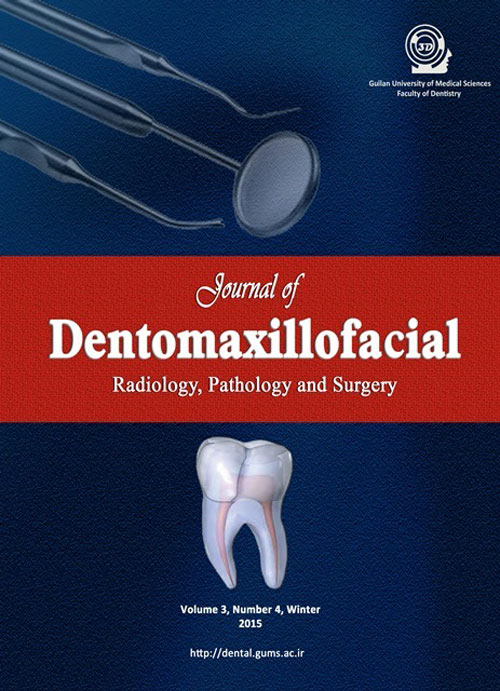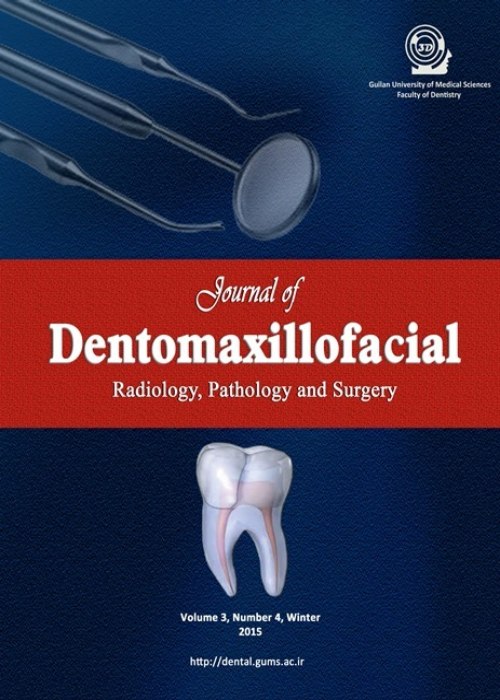فهرست مطالب

Journal of Dentomaxillofacil Radiology, Pathology and Surgery
Volume:5 Issue: 2, Summer 2016
- تاریخ انتشار: 1395/05/25
- تعداد عناوین: 6
-
-
Pages 1-5Introdouction: Dentists need to be able to diagnose jaw lesions due to professional responsibilities to refer affected patients for expeditious treatment as needed. The objective of this study was to assess the knowledge of senior dental students in Qazvin University of Medical Sciences regarding the interpretation of radiographic images of oral lesions. The study took place in 20112012.Materials And MethodsThis descriptive-analytical trial involved 36 dental students enrolled in the practical and theoretical radiology course and oral medicine during their final educational session. A questionnaire was designed, and students were asked to express their diagnoses following observation and interpretations of nine different diagnostic aspects in dental images in 3 questions and write the first probable diagnosis for 10 items in one question. The students scores were calculated and statistically analyzed by one-sided analysis of variance and student t-tests.ResultsThe students mean score was 14.32 ± 2.09, out of a maximum score of 20. The maximum and minimum scores of participants were 18.0 and 10.5, respectively. No significant differences were noted between the scores of male and female students.ConclusionIn total, participating students demonstrated an acceptable level of knowledge in the interpretation of radiographic images.Keywords: Dental Radiography, Dental Students, Knowledge
-
Pages 6-10Introdouction: Mucoepidermoid carcinoma (MEC) is one of the most common salivary gland malignancies. The prevalence of salivary gland tumors varies in different geographic areas. In this report, we evaluated the prevalence of MEC in Iran and compared it with that previously reported in other countries.Materials And MethodsThe files of oral pathology, Shahid Beheshti University of Medical Sciences, Amiralam and Taleghani hospitals, served as the source of the material from 2001 to 2011 for this study. Information, including patients age, gender, tumor location, clinical symptoms and histopathologic grade was recorded. Mann-Whitney test was used for statistical analysis.ResultsMucoepidermoid carcinoma accounted for 24.1% of salivary gland malignancies during the 11-year period. Most cases were diagnosed in the third to fifth decades of life and the male to female ratio was 1:03. The parotid gland was the most common location (49.5%). Tumor grading was available for 92 neoplasms and of them, 39.13% was graded low, 32.6% was intermediate and 28.26% was high grade. Swelling, pain and ulceration existed in 68.6%, 30.4% and 4.8% of patients, respectively. Forty-four point forty-five per cent of cases that demonstrated pain were high grade, 29.6% were intermediate, and 25.9% were low grade (p = 0.03). High grade tumors were more common in males (p = 0.06).ConclusionThe mean age, site of involvement, sex of patient, and microscopic grading of salivary gland MEC in the Iranian population were found to be similar to those of most other countries.Keywords: Mucoepidermoid Carcinoma, Salivary Glands, Neoplasms
-
Pages 11-16IntroductionMicroleakage is a major factor affecting the longevity of adhesive restorations. Colored compomer is a new restorative material that was specifically designed for the restoration of primary molars in different colors, but their microleakage is unknown. This study was carried out to compare the microleakage of a colored compomer (Twinky star) and a conventional compomer (F2000) with a microhybride composite (Z250).Materials And MethodsIn this in vitro study, class V cavities were prepared on buccal surfaces of 30 caries free extracted primary molars with gingival margins 1 mm below the Cemento Enamel Junction. The teeth were filled as follow: Group I: single bond2(3M, ESPE, USA) composite (Z250, 3M); Group II: Solobond M (VOCO, Germany) colored compomer (Twinky star, VOCO); Group III: single bond2 compomer (F2000, 3M).After polishing the restorations, all specimens were stored in distilled water for 6 days. Then, the samples were thermocycled for 500 cycles and placed in 0.5% fuchsine solution for 48 hours. The samples were sectioned longitudinally and evaluated for microleakage under a stereomicroscope (MoticMicro Optic, industrial group Co, LTD, Japan) at 40x magnification. Dye penetration was scored on a 04 ordinal scale. Data were analyzed using SPSS 14, Kruskal-Wallis, and Mann Whitney ranks tests. The level of significance was set at PResultsThere was no significant difference in the gingival microleakage of Twinky star and Z250 (P = 0.374), but the difference was significant between these two materials and F2000 compomer (PConclusionAccording to this study, due to their relatively low microleakage, special glitter, attractiveness to children, and release of fluoride, colored compomers might be an appropriate restorative material for restoration of primary teeth.Keywords: Composite Resins, Compomers, Dental leakage, Primary teeth
-
Pages 17-23IntroductionDetermining the skeletal age and remaining growth potential of patients are important factors in orthodontic treatment. Evaluating cervical vertebrae development is a reliable method for determining skeletal age. This study aimed to evaluate the correlation between dental calcification and stages of skeletal maturation.Materials And MethodsThis descriptive cross-sectional study was conducted on 84 panoramic radiographs and lateral cephalometrics related to 1015-year-old patients without systematic diseases affecting dental calcification and development. Patients skeletal age was determined by the stage of cervical vertebrae development and by using Lamparskis method. Dental age of samples was determined by Demirjians method. Findings were analyzed by SPSS 18 software using Spearmans correlation test to determine the correlation between the cervical vertebrae development and the dental development stages. PResultsSpearmans correlation test showed a significant direct correlation between dental age and skeletal age (r2 = 42.5%). The linear relationship between dental age and skeletal age was significant (pConclusionThe findings of this study showed that, in Demirjians method, stage G of the mandibular second premolar teeth in girls and stage F of the mandibular second molar teeth in boys was most frequent between developmental stages. According to the relatively high correlation coefficient between the dental age and the skeletal age, using dental calcification stages by panoramic radiography may become a simple first-level diagnostic test to determine skeletal maturity, which requires more studies in different ethnicities and places all around the world.Keywords: Tooth Calcification, Panoramic Radiography, Cervical Vertebrae, Age Determination by Skel, eton
-
Pages 24-32Introdouction: One of the existing problems in the field of dentistry is the use of utilizing materials. Utilizing materials in dentistry must have high rigidity and resistance and a beautiful appearance. The weak formulation of dentistry materials causes irritation, side effects, and increases the cost of healthcare. Therefore, farms and organizations related to dentistry care are trying to produce highly efficient products. Therefore, in the current research, we attempted to recognize and rank the factors that impact on the utilization of nanotechnology in dentistry by an MCDM Fuzzy approach. The statistical community of the present research includes dentists and university experts, who are active in the field of Nano- Dentistry in Mazandaran, Dentist College in Sari . They are selected by the consensus of two groups. The first group included managers and superordinate experts of the organization with 32 people for localizing the modeling. In the second group, five experts as the statistical sample were selected.Materials And MethodsThe descriptive method and descriptive survey were used. Therefore, by exploring the scientific texts, the criteria were recognized, and their reliability then proved by experts.ResultsBy using the screening (decimal-fuzzy), 21 factors were recognized as important and effective in the use of nanotechnology in dentistry. To determine the impact and influence of these factors, the DEMATEL technique was used.ConclusionAccording to the results, decreasing dental plaque had the most impact, and the cost of technology was the most influential factor..Keywords: Nanotechnology, Nano, Dentistry, Multi, ple, Criteria Decision Analysis, DEMATEL Tech, nics
-
Pages 33-37Introdouction: Dentigerous cyst is a benign developmental lesion of the jaw. It is most commonly occurs during the second and third decades of life and has rarely been reported in association with a deciduous tooth. We report a case of two-year old girl who presented with an unerupted central incisor. According to the radiographic findings, she was diagnosed with a dentigerous cyst and underwent surgical enucleation. The final diagnosis was confirmed by histopathological analysis. We briefly discussed the characteristics of similar cases.Keywords: Incisor, Deciduous, Dentigerous Cyst


